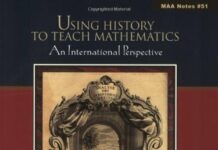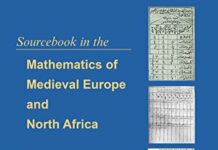
Ebook Info
- Published: 2021
- Number of pages: 701 pages
- Format: PDF
- File Size: 20.55 MB
- Authors: Victor J. Katz
Description
In recent decades it has become obvious that mathematics has always been a worldwide activity. But this is the first book to provide a substantial collection of English translations of key mathematical texts from the five most important ancient and medieval non-Western mathematical cultures, and to put them into full historical and mathematical context. The Mathematics of Egypt, Mesopotamia, China, India, and Islam gives English readers a firsthand understanding and appreciation of these cultures’ important contributions to world mathematics. The five section authors–Annette Imhausen (Egypt), Eleanor Robson (Mesopotamia), Joseph Dauben (China), Kim Plofker (India), and J. Lennart Berggren (Islam)–are experts in their fields. Each author has selected key texts and in many cases provided new translations. The authors have also written substantial section introductions that give an overview of each mathematical culture and explanatory notes that put each selection into context. This authoritative commentary allows readers to understand the sometimes unfamiliar mathematics of these civilizations and the purpose and significance of each text. Addressing a critical gap in the mathematics literature in English, this book is an essential resource for anyone with at least an undergraduate degree in mathematics who wants to learn about non-Western mathematical developments and how they helped shape and enrich world mathematics. The book is also an indispensable guide for mathematics teachers who want to use non-Western mathematical ideas in the classroom.
User’s Reviews
Reviews from Amazon users which were colected at the time this book was published on the website:
⭐Excellent service AND book condition. Very fast delivery. 100% Satisfied as allways with Amazon services.No further words need. Just excellent!
⭐This bulky, slapdash collection of source texts will hopefully be made superfluous by a better and more stringently organised one quite soon. Until then it is the only one of its kind so we have to read it anyway. Although many, many pages are devoted to elementary arithmetic and other trivialities of no historico-cultural interest, there are also a few occasions where cultural contextualisation is enjoyable. As illustrations of this, I shall summarise two selections on the use of similar triangles to measure heaven and earth.Chinese measurements of the heavens relied crucially on two cultural contingencies: that China is big and that it has bamboos in it.As Chen Zi says, “16,000 li to the south at the summer solstice, and 135,000 li to the south at the winter solstice, if one sets up a post at noon it casts no shadow. This single [fact is the basis of] the numbers of the Way of Heaven.” (p. 219, from The book of Chen Zi, in the Mathematical Classics of the Zhou Gnomon, compiled around the first century BCE.)Chen Zi is referring to the point S’ on the earth’s surface perpendicularly beneath the sun S. Now, standing somewhere else, we erect a bamboo tube BB’ so that its shadow falls at our feet O. Then (assuming that the earth is flat) OBB’ is similar to OSS’, so by measuring OBB’ and knowing OS’ we can calculate the distance to the sun from the earth, SS’. The value for SS’ reported by Chen Zi is 80,000 li, which is obviously ludicrous, suggesting that it was the cool idea rather than the actual result that interested him.Now, Chen Zi continues, pick up the bamboo tube you used as the post and point it towards the sun. Suppose its diameter is just big enough for you to see the whole sun through the tube (otherwise go get a longer or shorter tube). Then (length of bamboo):(bamboo diameter)::(distance to the sun):(diameter of the sun), where everything is know except the diameter of the sun, so now we know how big the sun is.While the Chinese thus utilised their benefit of having vast land and bamboo sticks at their disposal, the Muslims faced other circumstances in response to which they devised other methods. Al-Biruni (Book of the Determination at Coordinates of Localities, c. 1025, chapter 5) discusses a method for measuring the circumference of the earth akin to the Chinese method above, but does not find it feasible:”Who is prepared to help me in this [project]? It requires strong command over a vast tract of land and extreme caution is needed from the dangerous treacheries of those spread over it. I once chose for this project the localities between Dahistan, in the vicinity of Jurjan and the land of the Chuzz (Turks), but the findings were not encouraging, and then the patrons who financed the project lost interest in it.” (p. 628)Instead:”Here is another method for the determination of the circumference of the earth. It does not require walking in deserts.” (p. 628)The method is this. Climb a mountain. Let M be the mountain top, E its base, and C the centre of the earth. Now look towards the horizon and let H be the point furthest away from you that you can see. Then your line of sight is tangent to the earth’s surface, so the angle MHC is a right angle. Thus since we can measure the angle CMH we know all the angles of this triangle. We also know that CH = CE = radius of the earth, and we can measure EM, so we can solve for the radius of the earth.Al-Biruni did indeed carry this out:”When I happened to be living in the fort of Nandana in the land of India, I observed from an adjacent high mountain standing west from the fort, a large plain lying south of the mountain. It occurred to me that I should examine this method there. So, from the top of the mountain, I made an empirical measurement of the contact between the earth and the blue sky. I found that the line of sight had dropped below the reference line by the amount 0;34°. Then I measured the perpendicular of the mountain and found it to be 652;3,18 cubits, where the cubit is a standard of length used in that region for measuring cloth.” (p. 631) Al-Biruni goes on to calculate the radius of the earth from this data, which comes out as 12,803,337;2,9 cubits.The downside of this method is of course that it requires “a high mountain close to the seashore, or close to a large level desert.” Thus, coming across such a mountain is an opportunity too good to pass up even if you are in the middle of a war:”Abu al-Tayyib Sanad bin ‘Ali has narrated that he was in the company of al-Ma’mun when he made his campaign against the Byzantines, and that on his way he passed by a high mountain close to the sea. Then al-Ma’mun summoned him to his presence and ordered him to climb that mountain, and to measure at its summit the dip of the sun.” (p. 629)Why did the Chinese measure the heavens and the Muslims the earth? Shang Gao expresses the Chinese attitude: “one who knows Earth is wise, but one who knows Heaven is a sage” (p. 217). But in the Muslim world, different cultural circumstances conferred a higher status on earth-measurements:”If the investigation of distances between towns, and the mapping of the habitable world, … serve none of our needs except the need for correcting the direction of the qibla we should find it our duty to pay all our attention and energy for that investigation. The faith of Islam has spread over most parts of the earth, and its kingdom has extended to the farthest west; and every Muslim has to perform his prayers and to propagate the call of Islam for prayer in the direction of the qibla.” (Al-Biruni, p. 635)Note however the conditional “if…”, which is perhaps another hint that al-Biruni, like Chen Zi, does not consider practical gains to be the primary purpose of mathematics.
⭐This is a good source book in general, but some chapters are much better than others. The book is a collection of chapters written by different experts in the different historical areas. Some of the chapters are really good while others are mediocre.I liked the Egypt and China chapters the best.I found the India chapter with its repeated use of […] in the source material to be irritating at times. As to all the […]’s, I went to Google Books and found Colebrooke’s Algebra 1817 book to fill in the missing [….]’s with Colebrooke’s stilted 1800’s British translation.I did not like the selection of Babylonian tablets. There are tablets after tablets after tablets with no real coherent theme. A bit of the “Chinese style commentary” would have been greatly appreciated to help figure out what is actually going on in some of these tablets. There are a lot of good tablets shown, but there are also a lot of questionable choices for the tablets shown. Plimpton 322 is dealt with in all of half a page (p151) while there follow shortly after no less than fourteen pages of times tables and conversion rates: Ash 1924.796, W23273, W23283+22905, W23021. I question if this is really an appropriate choice of materials and wonder what were the editors thinking on this selection of materials?These two chapters could be better, but even in these weaker chapters there are some good parts. I used the tablet Ash 1922.168, with the areas left out, as a homework for my History of Math class. I was quite happy to finally figure out the “pulverizer” when I came to the note on page 416.Overall I give the book 4 stars and am happy with my purchase.
⭐This book is a must-have for teachers. It gives a comprehensive history of mathematics that every teacher should know. The book itself is well-written and moderately easy to follow, though some of the examples are advanced. It is a great reference and worth its price.
⭐aber noch keines zur Geschichte der Mathematik in den antiken Kulturen. Hier ist eines. Die Experten des Faches haben es zusammengestellt und es wird für lange Zeit DER Klassiker werden. Großartig!
⭐
Keywords
Free Download The Mathematics of Egypt, Mesopotamia, China, India, and Islam: A Sourcebook in PDF format
The Mathematics of Egypt, Mesopotamia, China, India, and Islam: A Sourcebook PDF Free Download
Download The Mathematics of Egypt, Mesopotamia, China, India, and Islam: A Sourcebook 2021 PDF Free
The Mathematics of Egypt, Mesopotamia, China, India, and Islam: A Sourcebook 2021 PDF Free Download
Download The Mathematics of Egypt, Mesopotamia, China, India, and Islam: A Sourcebook PDF
Free Download Ebook The Mathematics of Egypt, Mesopotamia, China, India, and Islam: A Sourcebook


